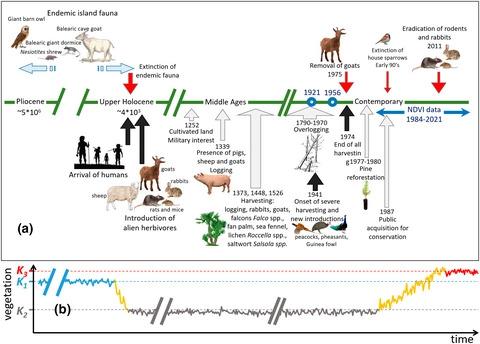当前位置:
X-MOL 学术
›
Glob. Change Biol.
›
论文详情
Our official English website, www.x-mol.net, welcomes your
feedback! (Note: you will need to create a separate account there.)
Long transient response of vegetation dynamics after four millennia of anthropogenic impacts in an island ecosystem
Global Change Biology ( IF 10.8 ) Pub Date : 2022-07-30 , DOI: 10.1111/gcb.16363 Daniel Oro 1 , Yolanda Pueyo 2 , Joan Bauzà 3 , Maria Paz Errea 2 , Antonio Ignacio Arroyo 1, 2
Global Change Biology ( IF 10.8 ) Pub Date : 2022-07-30 , DOI: 10.1111/gcb.16363 Daniel Oro 1 , Yolanda Pueyo 2 , Joan Bauzà 3 , Maria Paz Errea 2 , Antonio Ignacio Arroyo 1, 2
Affiliation

|
Agents of global change commonly have a higher impact on island ecosystem dynamics. In the Mediterranean region, those dynamics have historically been influenced by anthropogenic impacts, for example, the introduction of invasive species and overharvesting of resources. Here, we analysed the spatio-temporal dynamics of vegetation in sa Dragonera island, which experienced a large environmental change ca. 4000 years ago by the arrival of humans. Anthropogenic impacts, such as herbivory by goats and over-logging, ended in the 1970s, while in 2011 the site became the largest Mediterranean island where rats were eradicated. Invasive rats and goats played the ecological role of two endemic species, the cave goat and the giant dormouse, which inhabited the island for more than 5 million years and were rapidly extinct by humans. We used Landsat imagery to explore NDVI as a proxy of vegetation productivity over the years 1984–2021, orthophotos to assess changes in land and vegetation covers and historical plant inventories to study the dynamics in plant diversity. Results showed that those indicators steadily increased both in spring and in summer, while the noise around the trends was partially explained by climate variability. The regime shifts in the temporal dynamics of vegetation productivity suggested a transient from a perturbed to a non-perturbed stable state. Trends in successional dynamics, spatial self-organization and plant diversity also showed the same type of transient dynamics. Historical perturbations related to harvesting (mainly the synergies between goat browsing, burning and forest over-logging) were more important than rat eradication or the influence of climate to explain the vegetation dynamics. Our study shows the transient nature of this small island ecosystem after 4000 years of perturbations and its current path towards vegetation dynamics more controlled by ecological interactions lacking large herbivores and omnivores, drought dynamics and the carrying capacity of the island.
中文翻译:

岛屿生态系统四千年人为影响后植被动态的长期瞬态响应
全球变化的因素通常对岛屿生态系统动态产生更大的影响。在地中海地区,这些动态在历史上一直受到人为影响的影响,例如,入侵物种的引入和资源的过度开采。在这里,我们分析了 sa Dragonera 岛植被的时空动态,该岛经历了大约 10 年的大环境变化。4000年前人类的到来。山羊的食草和过度伐木等人为影响在 1970 年代结束,而在 2011 年,该地点成为消灭老鼠的最大地中海岛屿。入侵的老鼠和山羊发挥了洞穴山羊和巨型睡鼠两种特有物种的生态作用,它们在岛上栖息了超过 500 万年,并迅速被人类灭绝。我们使用 Landsat 图像来探索 NDVI 作为 1984-2021 年间植被生产力的代表,使用正射影像来评估土地和植被覆盖的变化,并使用历史植物清单来研究植物多样性的动态。结果表明,这些指标在春季和夏季都稳步上升,而围绕趋势的噪音部分是由气候变率解释的。植被生产力时间动态的制度转变表明从扰动到非扰动稳定状态的瞬变。演替动力学、空间自组织和植物多样性的趋势也表现出相同类型的瞬态动力学。与收获相关的历史扰动(主要是山羊浏览之间的协同作用,燃烧和森林过度采伐)比消灭老鼠或气候的影响更能解释植被动态。我们的研究表明,经过 4000 年的扰动后,这个小岛生态系统的短暂性及其目前的植被动态路径更多地受到缺乏大型食草动物和杂食动物的生态相互作用、干旱动态和岛屿的承载能力的控制。
更新日期:2022-07-30
中文翻译:

岛屿生态系统四千年人为影响后植被动态的长期瞬态响应
全球变化的因素通常对岛屿生态系统动态产生更大的影响。在地中海地区,这些动态在历史上一直受到人为影响的影响,例如,入侵物种的引入和资源的过度开采。在这里,我们分析了 sa Dragonera 岛植被的时空动态,该岛经历了大约 10 年的大环境变化。4000年前人类的到来。山羊的食草和过度伐木等人为影响在 1970 年代结束,而在 2011 年,该地点成为消灭老鼠的最大地中海岛屿。入侵的老鼠和山羊发挥了洞穴山羊和巨型睡鼠两种特有物种的生态作用,它们在岛上栖息了超过 500 万年,并迅速被人类灭绝。我们使用 Landsat 图像来探索 NDVI 作为 1984-2021 年间植被生产力的代表,使用正射影像来评估土地和植被覆盖的变化,并使用历史植物清单来研究植物多样性的动态。结果表明,这些指标在春季和夏季都稳步上升,而围绕趋势的噪音部分是由气候变率解释的。植被生产力时间动态的制度转变表明从扰动到非扰动稳定状态的瞬变。演替动力学、空间自组织和植物多样性的趋势也表现出相同类型的瞬态动力学。与收获相关的历史扰动(主要是山羊浏览之间的协同作用,燃烧和森林过度采伐)比消灭老鼠或气候的影响更能解释植被动态。我们的研究表明,经过 4000 年的扰动后,这个小岛生态系统的短暂性及其目前的植被动态路径更多地受到缺乏大型食草动物和杂食动物的生态相互作用、干旱动态和岛屿的承载能力的控制。











































 京公网安备 11010802027423号
京公网安备 11010802027423号